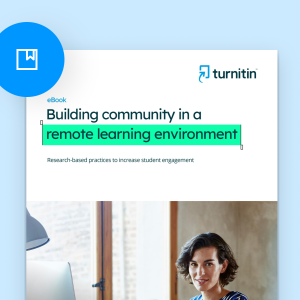The shift to remote and/or hybrid learning environments around the world has modified our definition of community. For many, “community” prior to the pandemic was based on in-person support, where students, families, and educators connected face-to-face on a regular basis.
And while that in-person community still exists, we have seen– with the help of technology and the internet–that our support network can, in fact, be so much larger and multi-dimensional than we once thought. We now know that our community can consist of peers across the world; it can involve mentors that live in different towns or countries; it can include opportunities for learning that don’t require us to be in the same physical location, but instead, allow us to take part in discussions from different latitudes and longitudes.
Yes, students and educators are still gathering to learn and share information, but more than ever, these learning communities are now taking place online and with the aid of education technology. And the implications of this are manifold.
If we can address access and effectiveness, as well as the myriad inequities that surfaced during the pandemic, then edtech tools can bring with them a strong sense of connectedness, inspiration for creative new ideas, and the chance for enriched productivity. There is a world where our new sense of community can thrive; where traditional offline learning and eLearning can go hand-in-hand.
So how do we harness the power of this new education community? Here are a few ways:
Embrace flexibility. Remote learning has brought with it an increase in asynchronous learning, where students may consume course materials at different times and in different places. Arizona State University (ASU) in North America, whose online programs will reach approximately 84,000 students this year, observed that “many online students choose to take fewer courses at a time and may take semesters off to accommodate other aspects of their lives like taking care of children or work responsibilities…[which is] part of why the flexibility of online learning is so appealing,” says Nancy Gonzales, the executive vice president and ASU provost.
Students and course materials aren’t the only things that have needed to be flexible. Established exams like the SATs in North America and the GCSE, AS, and A-level papers in the United Kingdom have also been adjusted on account of the pandemic. By shortening many of these exams, making them digital, and offering them in digital format with software like ExamSoft, some even say that it levels the playing field and makes the tests more accessible to those from different backgrounds.
Flexibility is a key component of a growth mindset, and it is through growth that student learning outcomes can be improved. Better time management, new technical skills, increased communication and collaboration, as well as a broader, global perspective are benefits of a flexible approach to education, to name a few.
Lean in to family and caregiver engagement. Over the past two years, families and caregivers have also been engaging with their school communities in a different way and often, to a greater degree. According to the Brookings Institution out of Washington, D.C., (USA), “Teachers around the world report developing creative ways of engaging with parents to help their students learn at home, including strategies they would like to continue even after the pandemic is over.” From WhatsApp and Facebook conversations, to Zoom parent/teacher conferences, families worldwide are utilizing new tools to connect to teachers and have found the connectivity to cultivate a greater sense of transparency, clarity, and collaboration between school and home.
Indeed, by engaging families, some of the limitations of remote learning have been mitigated. The World Bank published a report in 2021 entitled: Remote Learning During COVID-19 : Lessons from Today, Principles for Tomorrow (English), detailing our unique opportunity to reimagine the traditional model of school-based learning and underscoring the value of parents as key partners of teachers. By equipping families and caregivers with the necessary tools and information to support students remotely, we increase an individual’ s chance to find success, whether their learning community is in-person, online, or both.
Champion technology that enhances learning. In the spring of 2020, the Education Week Research Center surveyed K-12 educators across North America, asking how the coronavirus school closures have influenced the role and use of technology in K-12 education. More than eight in 10 teachers believed that their ability to use the technology improved, and that this made them better, more innovative educators.
Meaningful education technology can be a formative tool used to enhance–not replace–the role of the teacher. Educators will play a key role in the immediate future, not just in helping students adjust to the technological demands of distance learning, but in acting as advocates for expanding online learning opportunities to reach more students.
Imagine Learning (formally Edgenuity), is an education technology company that provides K12 curriculum across subject areas, as well as tools for intervention and resources for multilingual learners. Gradescope can be used in the classroom to administer and grade assessments, online or paper-based, and can help improve the effectiveness of a test, so as to give teachers the time to do what they want: teach, instead of grade. And Draft Coach, a Google Docs add-on for Turnitin Feedback Studio and Turnitin Originality users, can provide instant feedback on citations, grammar, and similarity as students research and write.
Not only can these tools save teachers’ time, but they can support student learning outcomes by helping to grow students’ skills across subject areas and prepare them with real-word skills. According to the World Economic Forum, “Innovative technology and solutions that make sense in different cultural and regional contexts can then be developed to help equip millions of young people with essential skills.”
Dr. Amjad, a Professor at The University of Jordan in Amman, starting using Lark as a communication tool to teach his students at the beginning of the pandemic. “It has changed the way of teaching,” he says. “It enables me to reach out to my students more efficiently and effectively through chat groups, video meetings, voting and also document sharing… My students also find it is easier to communicate on Lark.”
And while the digital divide still separates those who have access to reliable internet service and equipment from those who do not, it is safe to say that education technology will continue to play a critical role in our learning communities for years to come.
Harness a new sense of community. The world of education is starkly different from what it was three years ago. Students, families, and educators alike have seen a shift and it’s likely that we’re not heading back to what was, but instead embracing what can and will be. Oftentimes in education, disruption leads to innovation--curriculum change is hardwon. With thoughtful flexibility, continued family engagement, and continued implementation of meaningful technology, we can harness this new sense of community powerfully and together.





